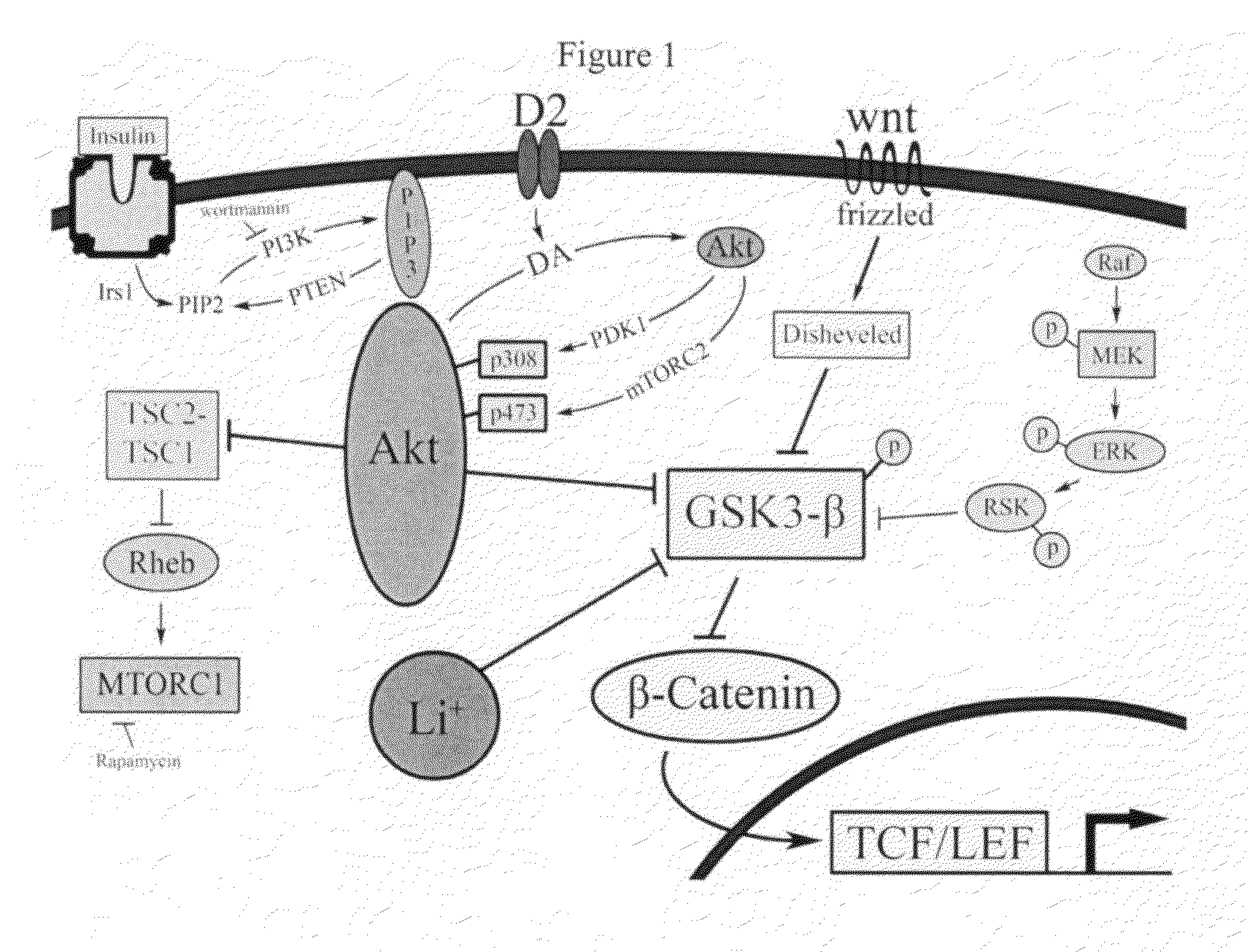Uses of chemicals to modulate GSK-3 signaling for treatment of bipolar disorder and other brain disorders
a technology of gsk-3 and chemical agonists, applied in the field of treating neurological diseases and psychiatric disorders, can solve the problems of no brain disorders, other than brain cancers, developed therapeutic compounds, and achieve the effect of reducing side effects
- Summary
- Abstract
- Description
- Claims
- Application Information
AI Technical Summary
Benefits of technology
Problems solved by technology
Method used
Image
Examples
example 1
Identification and Characterization of GSK3 Inhibitors
[0195]Of the small molecule kinase inhibitors that are in clinical development and / or are approved drugs, there were a total of 6 compounds that inhibited GSK-3β with IC50s less than 2.5 μM: ruboxistaurin (a macrocyclic bisindoylmaleimide), enzastaurin (an acyclic bisindoylmaleimide), midostaurin (an indolocarbazole), lestaurtinib (an indolocarbazole), 7-hydroxystaurosporine (an indolocarbazole), and sunitinib (an indole). The clinical use and known activities of these compounds toward kinases are summarized in FIGS. 2-7. Further follow-up dose response testing has indicated that ruboxistaurin, enzastaurin, midostaurin, and UCN-01 have IC50s less than 50 nM, while sunitinib (IC50 of ˜1.7 μM), and lestaurtinib (IC50 of ˜2.3 μM) were less potent.
[0196]Due to the enhanced selectivity, relative to the indolocarbazoles class, of the bisindoylmaleimide class of compounds, this class of compounds was tested in additional follow-up assay...
example 2
β-Catenin Stabilization by GSK-3 Inhibitors
[0198]When tested in the βCat-eGFP reporter assay, enzastaurin, ruboxistaurin, midostaurin, and sunitinib were all able to cause β-catenin accumulation, a sign of GSK-3 inhibition. FIG. 9 shows the dose response of the most potent GSK-3 inhibitors identified and known GSK-3 inhibitors. Each data point represents a mean±SEM (n=4) IC50s were calculated based on the logistic function in MicroOrigin Software. The in vitro GSK-3 kinase assay contained less than 0.3% DMSO in the final assay buffer. Microliter liquid dispensing was handled by Multidrop Combi (Thermo Scientific). Nanoliters of compounds were transferred to assay solution by CyBi-Well vario robotics system (CyBio). Luminescence signal was measured and recorded using an Envision Multilabel Reader (Perkin Elmer).
[0199]This result indicates that the compounds are cell permeable and able to affect GSK-3 / β-catenin signaling in intact cells. Since increasing β-catenin levels in the mouse ...
example 3
Synergy of GSK3 Inhibitors and Lithium In Vitro
[0200]The potential of lithium to potentiate the TCF / LEF signal of a GSK3 inhibitor was tested in HEK293 cells stably transfected with the βCat-eGFP TCF / LEF reporter. TCF / LEF reporter signal was measured in cells exposed to various concentrations of lithium chloride (0 mM, 1 mM, 4 mM, and 10 mM) in the presence of different concentrations of Chir99021 (FIG. 11). In the presence of lithium, both the maximum efficacy and the potency of Chir99021 in stimulating TCF / LEF response increased.
[0201]TCF / LEF reporter signal was measured in cells exposed to various concentrations of Chir99021 (0 μM, 1.5 μM, 3 μM, 6 μM, and 12 μM) in the presence of different concentrations of lithium (FIG. 12). In the presence of a high concentration of Chir99021a synergistic effect is observed with the addition of lithium whereas only an additive effect was observed at lower concentrations
[0202]TCF / LEF reporter signal was also measured in cells exposed to various...
PUM
| Property | Measurement | Unit |
|---|---|---|
| pH | aaaaa | aaaaa |
| volume | aaaaa | aaaaa |
| concentrations | aaaaa | aaaaa |
Abstract
Description
Claims
Application Information
 Login to View More
Login to View More - R&D
- Intellectual Property
- Life Sciences
- Materials
- Tech Scout
- Unparalleled Data Quality
- Higher Quality Content
- 60% Fewer Hallucinations
Browse by: Latest US Patents, China's latest patents, Technical Efficacy Thesaurus, Application Domain, Technology Topic, Popular Technical Reports.
© 2025 PatSnap. All rights reserved.Legal|Privacy policy|Modern Slavery Act Transparency Statement|Sitemap|About US| Contact US: help@patsnap.com



